Franklin Chang-Diaz (also known as Franklin Chang) was born in Costa Rica to a Chinese father and a Latino mother. As a youngster, he watched the stars from his roof with his little sister, and told his parents he was going to be an astronaut. Believing that the road to outer space went through the U.S., he left Costa Rica as a teenager, and went to the U.S. with $75.
He lived with relatives, and attended an American high school. A serious and ambitious student, he wore a jacket and tie to school. He received a scholarship to the University of Connecticut, then earned a doctorate at MIT, doing research in plasma-based rockets.
When NASA was looking for astronauts, he applied and was accepted. He called his parents, and told them that his childhood dream had been fulfilled; he was going into space. Eventually he was on seven space missions — more than any other astronaut.
When he retired from NASA, Chang-Diaz started Ad Astra Rocket Company, which is developing plasma-based rockets. These rockets travel faster than today’s rockets, and may enable manned flight to Mars, etc.
We’ve all heard that there are three kinds of matter — solids, liquids, and gases. Chang-Diaz adds a fourth: plasma. Plasma is the most common form of matter in the universe; stars consist of plasma. Plasma results from heating atoms to the point where their electrons break out of their usual shells, and go haywire. Higher temperatures and energy levels translate into higher rocket speeds.
Where will Chang-Diaz’s rockets get all this energy from? It all starts with nuclear power, which generates electricity, which is used to heat atoms to very high temperatures. Like an electric power plant, the rocket uses magnets to generate energy. Chang-Diaz’s rockets are scheduled to be tested in a couple years on a short flight to the International Space Station.
In Costa Rica, Chang-Diaz is a national hero.
A. In his New Guide To Science, Asimov moves from fact to fact, rarely pausing to reflect or philosophize. But when he discusses Bessemer, the man who invented a new way to make steel and thereby ushered in The Age of Steel, Asimov gives us a generalization that I found interesting: “[Bessemer] knew nothing of metallurgy, so he could approach the problem with a fresh mind.”1 I made a similar point in my book of aphorisms:
| In science, those who make revolutionary discoveries are often people who don’t specialize in the field that they revolutionize. Dalton, for example, who revolutionized chemistry, didn’t specialize in chemistry; Dalton revolutionized chemistry by applying to chemistry insights that he had acquired from meteorology and physics. |
The problem that Bessemer was trying to solve was how to make steel that wasn’t as brittle as cast iron, nor as labor-intensive as wrought iron. Cast iron was brittle because it had a high carbon content; wrought iron was labor-intensive because removing carbon was tedious. Bessemer’s invention was a “blast furnace” that blasted air through molten iron, removing just the right amount of carbon, with little labor.
B. Asimov says that, 80 million years ago, ocean temperatures averaged 70º F, and then they declined gradually to their present level of 35º F.2 This dramatic cooling of the oceans may have contributed to the extinction of the dinosaurs, who were suited to a warmer world. During its 4.5 billion years of existence, the earth has experienced dramatic temperature changes, and there’s every reason to believe that significant temperature changes will occur in the future — with or without human interference. These changes will make some latitudes and altitudes uninhabitable, while making others more habitable; some species will benefit, others will suffer.
C. In the late 1800s, the first subatomic particle was discovered: the electron. Next came the proton. With the discovery of the neutron, simplicity was lost.
| In a very important respect [writes Asimov] the discovery of the neutron disappointed physicists. They had been able to think of the universe as being built of just two fundamental particles — the proton and the electron. Now a third had to be added. To scientists, every retreat from simplicity is regrettable. The worst of it was that, as things turned out, this was only the beginning. Simplicity’s backward step quickly became a headlong rout. There were more particles to come.3 |
My theory of history has a certain simplicity. According to my theory, societies have life- and death-instincts; renaissance and decadence are manifestations of these instincts. Life and death and nothing more.
D. An electron has a negative charge; a proton, a positive charge. But what exactly is a “charge”? Asimov says, “we know what [a charge] does and how to measure its properties, but we do not know what it is.”4 In my book of aphorisms, I wrote, “Newton was content to state the laws of gravity though he was ignorant of what gravity actually was, just as quantum physics doesn’t know what a quantum actually is.” My theory of history is about the life- and death-instincts, but I don’t know what those instincts actually are.
E. Early scientists dealt with the periphery of the atom — giving or receiving electrons. Later scientists penetrated into the nucleus of the atom — nuclear fission, fusion, etc. Likewise, early novelists like Fielding and Scott dealt with the outer world, while later novelists, like Proust and Kafka, depicted the mind itself — how the mind bends the external world.
F. Asimov tries to prevent a non-rational worldview from drawing any sustenance from modern physics — in short, he tries to prevent people like me from using modern physics as I’ve used it. He tells us that “[Heisenberg’s] uncertainty principle means that the universe is more complex than was thought, but not that it is irrational.”5 Though light seems to be both a particle and a wave, we shouldn’t conclude that truth is contradictory; Asimov complains that light “has been made to seem a paradox, or even a kind of mysticism [horrors!], as if the true nature of light passes all possible understanding.”6
Discussing the history of radio, Asimov says that the physicist Oliver Joseph Lodge “later gained a dubious kind of fame as a champion of spiritualism.”7 To call such fame “dubious” is to overlook the fact that one of the leading philosophers of the time, William James, had a keen interest in the occult, as did one of the leading poets of the time, W. B. Yeats, and one of the leading psychologists of the time, C. G. Jung — not to mention the wealth of evidence in support of this viewpoint, evidence that Asimov chooses to ignore.
G. Asimov insists that nuclear power can be constructive as well as destructive. Nuclear power shouldn’t cause us to take a negative view of science in general — something that Americans are apt to do, with their “rather strong Rousseauan tradition against book learning as a corrupter of the simple integrity of human beings in a state of nature.”8 Has Asimov captured, in this sentence, the essence of Richard Hofstadter’s book, Anti-intellectualism in American Life?
In an earlier issue, I said that, in the U.S., more and more children were contracting cancer, and the cause was unknown. Asimov discusses possible causes of cancer, such as radioactive isotopes like Carbon-14 and Strontium-90, both of which can be found in the human body. Carbon-14 occurs naturally; it is part of the “background radiation” that has existed longer than the human race. The presence of Carbon-14 in genes could cause genetic mutations, and perhaps cancer.
Strontium-90 is man-made, a by-product of nuclear fission. When it enters the human body, it often ends up in bones and bone marrow. According to Wikipedia, “Its presence in bones can cause bone cancer, cancer of nearby tissues, and leukemia.” Oddly enough, when it is controlled, Strontium-90 can be used to treat bone cancer. According to Asimov, “Children average at least four times as high a concentration [of Strontium-90] as adults, because of the higher turnover of material in their growing bones.”9
After reading such things, one must question the wisdom of nuclear tests, such as the tests made in the 1950s of hydrogen bombs. After an American test in 1954 in the Pacific, “Seven thousand square miles were seriously contaminated — an area nearly the size of Massachusetts.”10 The fallout from such bombs spreads over half the world. In my view, George Kennan is one of the most persuasive of those who have argued that the U.S. should have been less competitive in its nuclear arms race with the Soviets.
My wife and I visited two Chinese practitioners of Chinese medicine: Dr. Zhao Mei of Portland, Maine, and Dr. Guangli Xu of Brookline, Massachusetts.11 Dr. Mei has acquired a reputation, in the Portland area, for helping cancer patients. She was trained in Western medicine in China, then learned about the Chinese approach to qi from a qi master whom she met in the countryside, during the Cultural Revolution. She uses vigorous massage to get the qi moving properly. She has good intuition about health — overall health.
She tested our ability to stand firm despite pressure, pulling our hand down in an attempt to move us. Then she placed a cell phone in our opposite hand, and repeated the test. When we held the cell phone, we seemed to have no strength, and could be moved easily. The cell phone appeared to have negative energy, negative qi. (Of course, a skeptic would say that the person performing the test can determine its outcome by varying the amount of pressure applied.)
A Portland chiropractor, Robert Deutsch, performs the same test with bottles of medicine. He asks you to hold each of your bottles in turn, tests whether you can stand firm under pressure, then says “you stood firm while holding this bottle, so this medicine is good for you.” Perhaps chiropractors have a less rational-scientific approach to medicine, a more “alternative” approach, than other doctors.
When Dr. Mei told Yafei to soak her feet, Yafei said she had an electric soak-and-massage device. Dr. Mei said, don’t use it; she seemed to think that electric devices, like cell phones, have negative qi. Is this an argument for a simple, old-fashioned, un-electrified lifestyle, such as the Amish lead?
I asked Dr. Mei, what is qi? She said qi is the invisible part of a person. She said that she had developed her qi for years, and now possessed strong qi. She said that qi can be transferred to an object, such as a comb or a coin; she said that such qi-filled objects are sometimes sold.
While Western medicine seeks a cause of cancer in genes, in something tangible, Dr. Mei seeks a cause of cancer in stress and sorrow, in something intangible. She told us that one of her cancer patients had a child who changed his gender. The patient didn’t tell anyone about this gender-change, and the emotional burden of this secret led to cancer (in Dr. Mei’s view).
I was impressed with Dr. Mei, but Yafei didn’t feel better after the massage, so we sought a less-distant practitioner of Chinese medicine, and found Dr. Xu in Brookline. He uses Chinese herbs and acupuncture.
A. I recently sold some books through Amazon (the new version of my book of aphorisms). To print more copies, I use a printer called Lightning Source, who specializes in print-on-demand. Another printer who serves the self-publishing market is Lulu. Lulu will even help you with cover design. One might describe Lulu as a vanity press for the digital age. If you don’t want to print small batches, if you want to print, say, 500 copies, consider Morris Publishing.
B. In recent weeks, I approached a few publishers and literary agents about Realms of Gold: A Sketch of Western Literature. I only wanted to approach a few because I knew it was a hopeless endeavor, and I didn’t want it to be endless as well as hopeless. The chances of interesting a publisher in a non-fiction literary work are so slim that it might be wise not even to try — just go straight to web-publishing or self-publishing. Or shout from a rooftop, or from a Hyde Park soap-box. Now I’m moving forward with a self-publishing project, hoping that one of my two books will gain some sales momentum, and help the other one.
I discussed the Chinese health care system with a friend from China. Unlike the American system, the Chinese system doesn’t allow poor people to present themselves at an Emergency Room, and receive care. If they can find a government clinic, poor people might receive some care, but only a limited amount. Unlike an American hospital, a Chinese hospital might allow a poor person to die on the sidewalk.
As for the elderly, they don’t receive government health insurance, as they do in the U.S. My friend told of a family that filled a suitcase with cash, and left it with their elderly mother. A cash-filled suitcase is the elderly person’s health insurance, and woe to those who don’t have such a suitcase. My friend told of a 68-year-old man who committed suicide because he couldn’t afford more treatment for his illness, and didn’t want to burden relatives with his hospital expenses. He had been a teacher with health insurance, but when he retired, he lacked insurance.
In China, an elderly person who joined the Communist Party before 1949 (when the Communists took power) receives good treatment, at government expense. Those who have a government job, or a job with a big corporation, receive health insurance. But the majority of Chinese must scramble for health care, and are lucky to receive even mediocre care.
We hear much about the ethnic-religious divisions in Iraq: the Shiite majority that was long oppressed but is now in power, the Sunni minority that was long in power but is now less powerful, and the Kurd minority that controls northwestern Iraq. But we don’t hear much about Afghanistan’s ethnic divisions. (These divisions are, however, the focus of a movie called The Kite Runner.)
A recent article in the New York Times discussed Afghanistan’s ethnic divisions.12 It said that the chief ethnic groups in Afghanistan were the Pashtuns, the Tajiks, the Hazara, and the Uzbeks. The Pashtuns make up the largest percentage of the population: 42% (the total population is 33 million). A Pashtun monarchy ruled Afghanistan for about 250 years, until 1973. Now, however, the Tajiks possess most of the power, perhaps because they resisted the Taliban most effectively, and became closely allied with the NATO forces that ousted the Taliban. Because the Tajiks are dominant, the Pashtuns are discontent, and the Taliban draws much of its support from these discontented Pashtuns. Afghanistan’s President, Hamid Karzai, is Pashtun, but he has gone along with the Tajiks. The article concludes,
| The psychological cement that holds the disparate Taliban factions together is opposition to Tajik dominance in Kabul. Until the power of the [Tajiks] is curbed, no amount of American money or manpower will bring the insurgency to an end. |
So the challenge in Afghanistan, as in Iraq, is to overcome ethnic divisions, to involve all ethnic groups in the political process, to enable all ethic groups to feel that it’s their country and their government, and to let no ethnic group enjoy a monopoly of power.
While visiting Nantucket this summer, I finally grasped the architecture of Sconset (Sconset — also known as Siasconset — is the most significant town on Nantucket, outside of the town of Nantucket itself). I looked at a book called Sea Captains’ Houses and Rose-Covered Cottages: The Architectural Heritage of Nantucket Island.13 After a few minutes with this book, I knew things that I had never learned in decades of visiting Sconset, such as:
- The old core of Sconset is made up of four short streets: Front, Broadway, Center, and Shell.
- The old houses are called “whale houses” because the original inhabitants practiced near-shore whaling (as the Native Americans did). These original inhabitants also fished for cod, etc. (as the original inhabitants of “Cape Cod” did).
- The original whale houses were simple, small, one-story rectangles, perhaps 10 feet by 14 feet. None of these simple rectangles remain — or rather, many of them remain, but not in their original form.
- Later the inhabitants extended one end of the rectangle, to form a T-shaped house. The first T-shape seemed to inspire a wave of imitation, and soon every rectangle had become a T-shape.
- Later still, the other side of the rectangle was extended, to form a double T (or perhaps I should say, to form a capital I). Several of these double T’s remain; one might say that this is the quintessential Sconset cottage.
- Small additions, called warts or flounders, were added by some homeowners, and 2nd stories appeared on some houses.
- In the late 1800s, Sconset became a popular tourist spot, and actors colony. A man named Edward Underhill built several cottages on the south side of Sconset (Lily Street, Evelyn Street, etc.). The Underhill cottages were modeled after the old whale houses — small, single-story, double T-shape. So after you’ve walked through the old core of Sconset, walk over to the Underhill section, and see how the old style was imitated. Isn’t culture about imitation, just as much as creation?
- Just as well-known as Sconset’s “old core” is Sconset’s Bluff Walk, which passes through numerous front yards, and offers a view of the ocean. One might compare the Bluff Walk to the longer Cliff Walk, in Newport, Rhode Island.

Nauticon Lodge at 4 Broadway, dated 1734.
Note the “single T” shape.

The Maples at 14 Broadway, built in the early 1700s.
Note the “double T” shape.
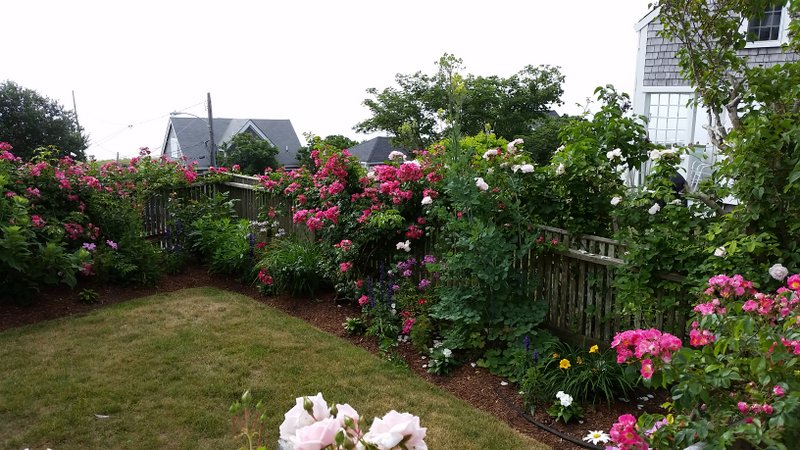
Sconset is known for its gardens and its roses.

| This route is an abbreviated Bluff Walk; the actual path extends further north. |
If you’re in downtown Nantucket, you may notice two white, obelisk-shaped stones about 75 yards apart — one on Fair Street, the other on Main Street. These are “meridian stones,” erected in 1840, probably by William Mitchell, who worked at the Pacific Bank nearby, lived with his family above the bank, and observed the stars from the roof of the bank. In 1847, Mitchell’s daughter, Maria, became world-famous when she discovered a comet from the roof of the bank. Like many Nantucketers at that time, the Mitchells were Quakers; they were related to Benjamin Franklin, whose mother, Abiah Folger, was born on Nantucket.

The southern meridian stone on Fair Street,
with the Quaker meeting house in the background.
The meeting house was built in 1838.
A line between the meridian stones would be a north-south line, a meridian line, and it would allow a sea captain to measure the difference between true north and magnetic north. Magnetic north is the result of the attraction between the compass needle and molten iron in the core of the earth. Magnetic north changes from time to time and from place to place, perhaps because the molten iron inside the earth is moving around.
So a sea captain, having arrived in Nantucket harbor, could ascertain his magnetic declination (that is, the angle between true north and magnetic north), perhaps with help from William or Maria Mitchell. The captain could also get his chronometer (his clock) adjusted by the Mitchells, who could tell him what the real time was, and at what rate his chronometer was gaining (or losing) time. Sea captains needed to know accurate time because they determined their position at sea by noting the position of a certain star at a certain time. After a visit to The Mitchells, a sea captain could sail the seven seas with confidence. (For more on Nantucket’s meridian stones, click here.)

The northern meridian stone on Main Street,
with the Pacific Bank behind it, and cobblestones in front.
Perhaps the best way for a tourist to get his bearings in downtown Nantucket is to walk west on Broad Street to Centre Street, then south on Centre to Main Street, then east on Main to Easy Street, then north on Easy until he’s back on Broad. This route forms a square that encloses the core of downtown Nantucket; this route is about one mile long. At the center of this square, on the corner of Federal and India Streets, is the Nantucket Atheneum, a public library. Just to the north, on Federal Street, is the Tourist Information Center. This square is the area that was burned in the Great Fire of 1846, and marble tablets in the sidewalk mark the four corners of the “fire area.”
|
If you have energy left, walk to Brant Point, where you’ll have a good view of the harbor (you can reach Brant Point from Broad Street by walking north on South Beach Street, then east on Easton Street). Or you can explore the less-crowded periphery of town, perhaps with the help of one of the self-guided tours developed by the Nantucket Preservation Trust. Or take one of the many guided tours (there are ghost tours, architecture tours, history tours, bird-watching tours, etc., just ask at Tourist Information, or check the newspaper). Many tours are led by Bill Jamieson (508-332-0953).
Here’s a route that takes you from the center of town to the old windmill — a 2-mile circle. The circle begins and ends at the Pacific Bank, which is at the intersection of Main Street and Center Street. If you’re driving, you may want to park at the windmill, and start the circle from there.
In case the map is unclear, here’s a description of the route:
 The Pacific Bank, built about 1818.
 Ray’s Court is a quiet, shady, unpaved street.
 92 Main Street, built 1838 Note the elliptical fan over the door.
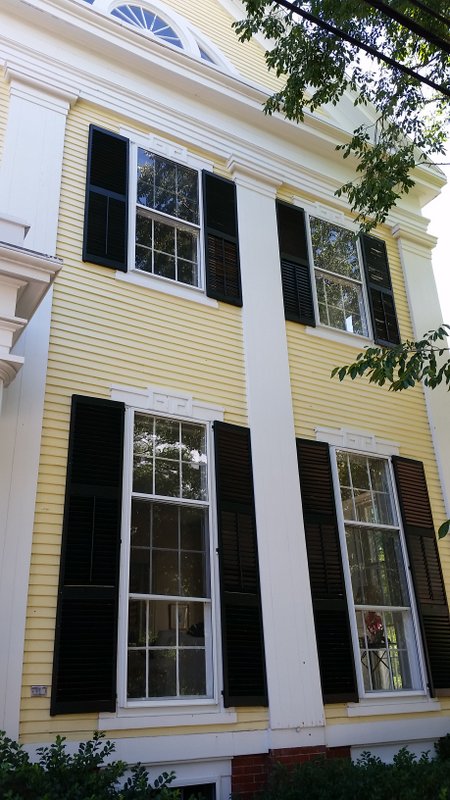 1 Pleasant Street, built 1837. Note the Greek key designs over each window.
 19 Pleasant Street, known as “Moors End.” Nantucket’s first brick house, built 1829. Note the semi-circular fan over the door. Below is a route created by Young’s Bike Shop; they offer a printed map with this route and other information. This route is 5 miles long; though it’s designed for biking, it’s also suitable for walking. It includes “history highlights” such as the Windmill, the Jail (or ‘Gaol’), and the Oldest House. It also includes water views at Brant Point and Step Beach. I added a stop at “Greater Light,” a house that was adorned by two creative sisters.
Below is a route that takes you from the center of town through two parks, then back to the starting point. It’s only 1.6 miles, but it has some interesting sights, like the Oldest House and the North Church (also called the First Congregational Church). Like the Windmill Loop, this route begins and ends at the Pacific Bank. If you’re driving, you may want to park at Lily Pond Park, and start the walk from there.
In case the map is unclear, here’s a description of the route:
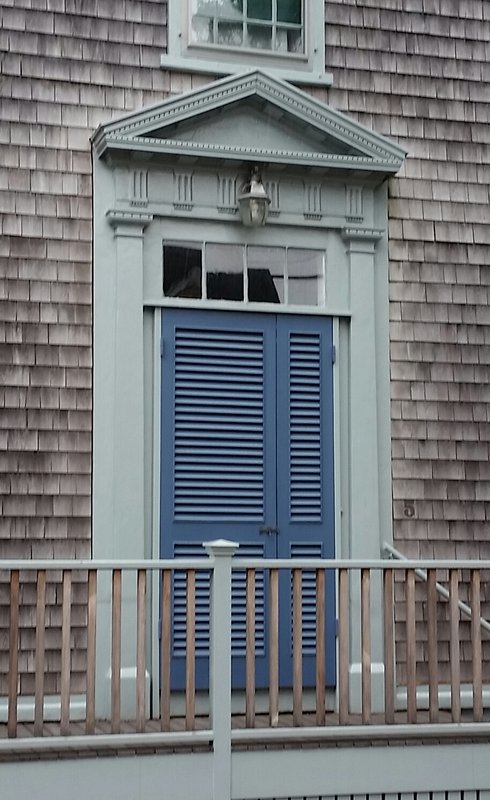 5 Gay Street Note the transom over the door, the pilasters, the pediment, and the triglyph pattern between the pediment and the transom.
 Main Street, south side, near Pacific Bank probably 58 Main Street the Doric columns are aging, and losing their fluting, but the triglyph pattern can still be discerned above the columns
 North Church, 62 Center Street The pointed arches indicate Gothic Style — unusual on Nantucket
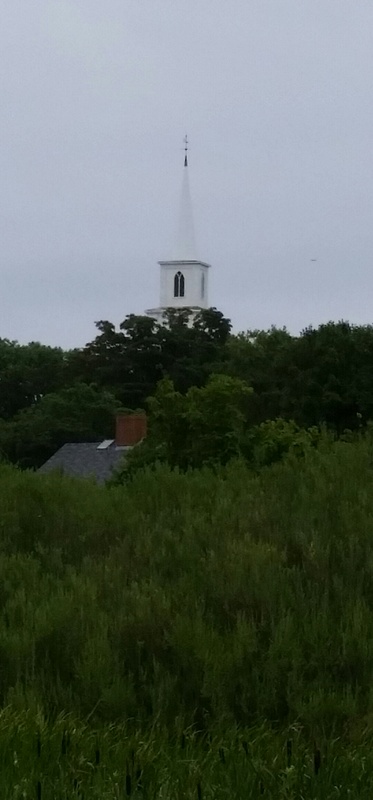 North Church rising above the reeds at Lily Pond Park Nantucket doesn’t have skyscrapers; North Church is one of the most conspicuous buildings on the island.
 The Oldest House is also the house with the fewest windows, and the smallest windows, and the diamond-shape window panes. built 1686
A tourist on Nantucket might also want to visit Altar Rock, which is reached via a dirt road off the Polpis Road. Altar Rock is one of the highest points on Nantucket, and it gives you a good view of the island. It also introduces you to Nantucket’s “empty center” — the moors, the dirt roads, etc. — a good area for mountain-bikers, joggers, and walkers. Another high point on the island, with a good view, is the steeple of the North Church. Pay a small fee, then climb the 94 steps. If you want to walk through the moors, visit the Sanford Farm property off Madaket Road (1.5 miles from the junction of Madaket Road and Quaker Road, on the left side of the street); the property is owned by the Nantucket Conservation Foundation. A 3-mile trail goes along Hummock Pond to the beach (near Cisco); there are also shorter loops. The flat country offers broad vistas, a big sky, and soaring hawks. The trail is well marked, with signs describing the history and ecology of the area. When the trail reaches the beach, you can turn left (east) and walk along the beach for 5 or 6 miles to Miacomet Pond, or to Surfside; or you can turn right (west) and walk a shorter distance to Madaket. Another country walk, somewhat shorter, is Tupancy Links (click here for map). While the Sanford Farm trail goes to the south shore, Tupancy goes to the north shore, and offers a view of Jetties Beach, etc. Two other refuges with good trails are Windswept Bog, in the northeast corner of the island, and Linda Loring, in the northwest corner. Windswept is next to other refuges, such as Stump Pond, hence you can walk for miles. On the other hand, Linda Loring is smaller, but it has lots of information about nature. Below is a map showing Windswept Bog and various places along the Harbor.

Nantucket Harbor, looking west from Monomoy. On the right is the pointed steeple of North Church, on the left is the rounded dome of South Church. Below is one of my favorite Nantucket walks, a 2-mile route that starts (and ends) at a conservation area called Leedsmoor. The above route starts at a small parking lot on the Polpis Road, and goes southeast to a dirt road called Almanac Pond Road. To lengthen the walk, you could go further east into Windswept Bog, or west into other conservation areas. The Coast to Coast Trail is a 25-mile trail that goes from Sconset to Madaket (as of 2021, it appears that the trail is only marked from east to west); it’s suitable for biking or hiking. Below is a map of the eastern section, which is 8.5 miles long (I made some wrong turns, which made the route longer). Much of it is on dirt trails, some is on dirt roads, some is on paved bikepaths, none is on the beach. For more info, download the app ACKtrails, or ask for a printed map at the Land Bank or the Information Center.
You can’t rely on your phone for map/directions; as of 2022, cell reception is spotty in the empty parts of Nantucket. So you’ll need to “look sharp” for trail markers, and download a map from the ACKtrails app. The eastern section of the Coast to Coast Trail goes through scrub forest where the trail is narrow, then goes through fields. The fields are hilly — a good example of a moraine landscape. Where there’s a moraine, you often find erratic boulders. Below is a picture of a boulder. It’s on a hilltop, and it’s part of a boulder train. 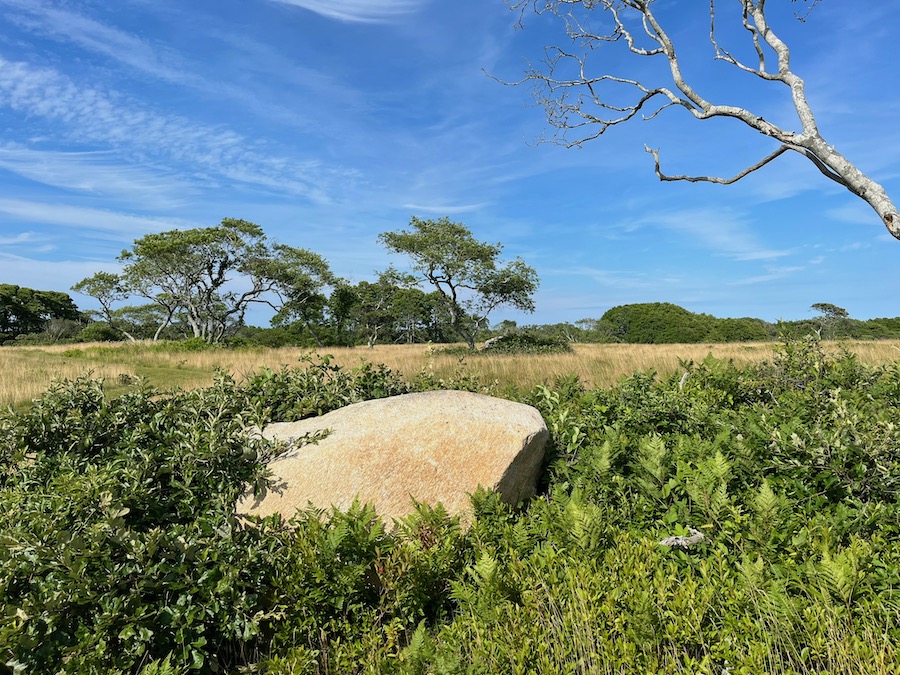
When you finally reach Milestone Road, the trail begins going through pine woods; this might be the best part of the trail for biking. Below is a map of the middle section of the Coast to Coast Trail; this section is 10 miles long. Since this section is on the southern half of the island, the terrain is often flat — an outwash plain.
Below is the western section of the Coast to Coast Trail. This section is 6 miles long, and goes through moors; you can ride steadily, albeit somewhat slowly. The western terminus is a bench with a view of Madaket Harbor, Eel Point, and Tuckernuck Island.
Below is a shorter version of the central section of the Coast-to-Coast Trail:
Below is an alternate version of the east section of the Coast-to-Coast Trail (link here); this version starts north of Sesachacha Pond, at the east end of Sesachacha Road (the other version starts at the east end of Hoicks Hollow Road, which is south of Sesachacha Pond, and north of Sankaty Lighthouse). 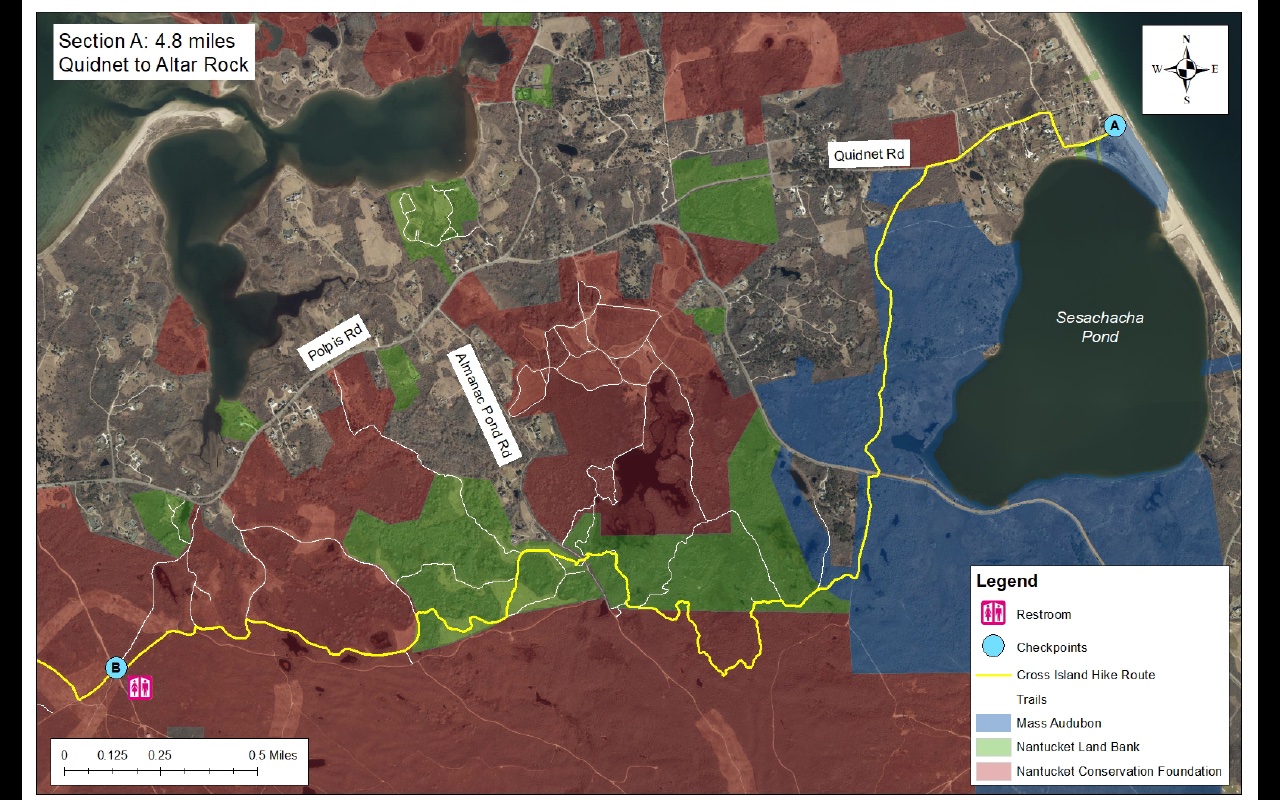
The above route was used in 2023 for the Land Bank’s annual coast-to-coast walk. They like to follow different routes on their annual walk. Below is a route of .7 miles (1.4 round-trip). It starts at a parking lot on the Polpis Road, and goes to a scenic spot called Jim’s Hill. From this hilltop, you can see Sankaty Light and Altar Rock in the east. To the north, you can see the harbor, Coatue, and Great Point (and the lighthouse at the end of Great Point). This hilltop is on the Coast to Coast Trail, so you could walk or cycle east toward Sconset, or west toward Miacomet.
Below is a route that goes along the beach from Surfside to Miacomet Pond, then follows the Pond north, then turns east on a trail, then follows paved roads back to the starting-point.
I recommend a self-guided tour of Nantucket’s trees. It’s a rather long tour; you may want to do it over two days. It takes you through some interesting neighborhoods, and teaches tree-identification. A map of the tree tour can be obtained from the Information Center on Federal Street. UMass has a Field Station on Nantucket, which is open to the public, and offers a good view of the harbor; there are trails through the undergrowth. Below is a 3-mile route that links Surfside to the Polpis Road (Moor’s End Farm on the Polpis Road). This route is an easy walk, a slightly-challenging bike ride.
Everything is expensive on Nantucket. Perhaps the most affordable lodgings are at the Youth Hostel at Surfside [update 2021: the Hostel is closed]. The Hostel is in a handsome old building, once a LifeSaving station (CoastGuard station); the building is similar to the LifeSaving station (now a LifeSaving museum) on Polpis Road. The architecture is probably Carpenter Gothic. I recommend a film by Ric Burns called Nantucket (2011). It’s about one hour long, has great images of the island, and summarizes the island’s history. My only complaint is that the writing is too poetic, too flowery. The film isn’t easy to borrow, but it can be purchased from the Nantucket Historical Association. Palmette Ornament that resembles fan-shaped leaves of a palm tree. Also called honeysuckle or anthemion.
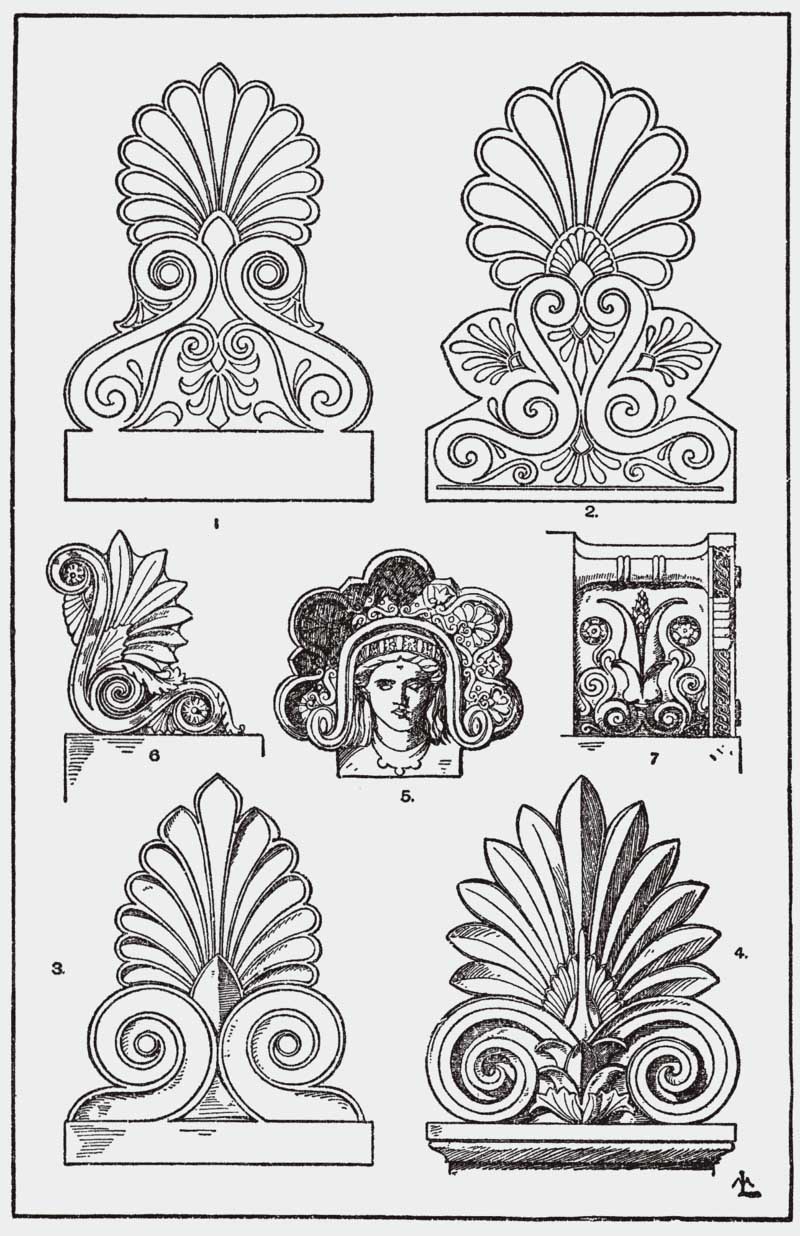 Palmettes
 Palmettes on fence at Providence Athenaeum
 The palmette is often found on a roof line, where it’s called an antefix.
Patera Round classical ornament, often seen in the corner of doorways, derived from a shallow bowl (“patera” is Latin for “bowl”).
 Patera Designs
 Patera from a wooden table
 Festoon draped over oval patera
Triglyph From the Greek word for “triple groove.” Pronounced “TRY glif.” One of the most common classical ornaments. Dates back to ancient Greece. Originally the triglyph was an imitation of a feature of older wooden buildings, an imitation of the notches on beam ends. 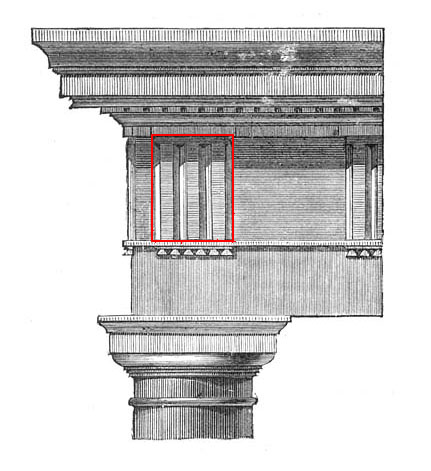 Triglyph
 Triglyphs In the doorway below, the triglyphs are between the pediment and the transom (also known as “transom window” or “transom light”).

For more on architecture terms, visit © L. James Hammond 2009 |
| Footnotes | |
| 1. | Ch. 6, p. 310 back |
| 2. | Ch. 4, p. 205 back |
| 3. | Ch. 7, p. 330 back |
| 4. | Ch. 7, p. 347 back |
| 5. | Ch. 8, p. 410 back |
| 6. | Ch. 8, p. 388 back |
| 7. | Ch. 9, p. 442 back |
| 8. | Ch. 10, p. 477 back |
| 9. | Ch. 10, p. 486 back |
| 10. | Ch. 10, p. 485 back |
| 11. | Dr. Mei uses the name Chinese Healing Arts Center, Dr. Xu uses the name Acupuncture Clinic of Brookline. back |
| 12. | “Afghanistan’s Tyranny of the Minority,” by Selig Harrison, 8/16/09 back |
| 13. | Another book on this topic is The Architecture of Historic Nantucket, by Clay Lancaster. back |